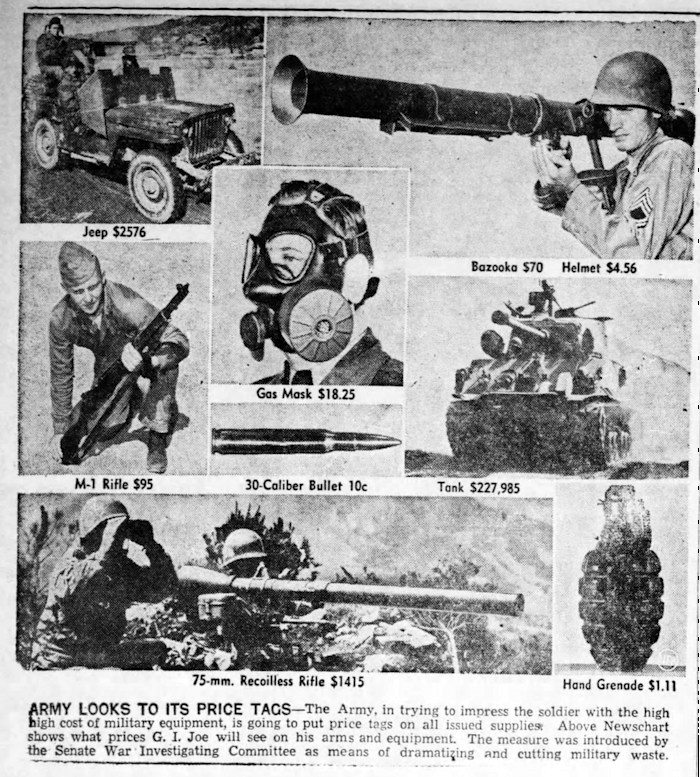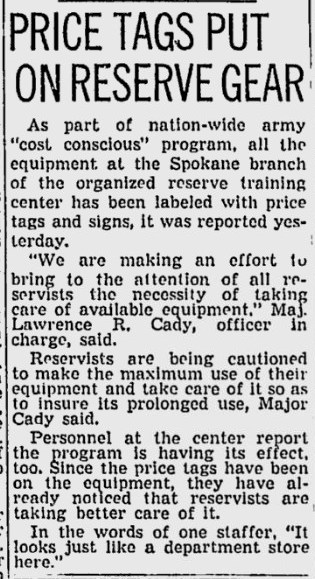Army puts price tags on equipment
Back in 1951, the U.S. Army was told it needed to cut costs, so it initiated the "cost-consciousness" program. This involved putting price tags on all the equipment, so that the soldiers could see how much everything cost. The theory was that this would make them use the equipment more "wisely and well."
After the program was implemented, one Army Reserve staffer said, "It looks just like a department store here."
There were claims that the program saved the Army millions of dollars. So I wonder what caused it to be shelved?


After the program was implemented, one Army Reserve staffer said, "It looks just like a department store here."
There were claims that the program saved the Army millions of dollars. So I wonder what caused it to be shelved?

The News-Herald (Franklin, Pennsylvania) - Dec 14, 1951

The Spokesman-Review - Feb 27, 1952
Comments
What caused it to be discontinued? I'm guessing some self important pricks ala Major Frank Burns not allowing necessary equipment to be used in justified situations due to the 'price'.
Posted by Patty in Ohio, USA on 11/12/15 at 09:11 AM
I would guess that with the price tags, it became a lot easier to run a black market
Posted by crc on 11/12/15 at 11:12 AM
Joe1: THEY'RE COMING OVER THE HILL!! HIT'EM WITH A GRENADE
Joe2: NO WAY, SARGE, THOSE THINGS COST OVER A DOLLAR EACH!
Yea, I can envision that.
Joe2: NO WAY, SARGE, THOSE THINGS COST OVER A DOLLAR EACH!
Yea, I can envision that.
Posted by Expat47 in Athens, Greece on 11/12/15 at 12:06 PM
Wow! I can get a bazooka for $70 and hand grenades for $1.11/ea. Sign me up.
Posted by RobK on 11/12/15 at 12:36 PM
All of the above reasons. Also, people in general have a tendency to gloss right over finances that are too huge to imagine, but will kick up a real stink over small amounts they can imagine. For example, they'll sign off without blinking on paying a quarter of a million for a tank, but will argue for hours over whether they can save a penny a case on 30-cal ammo.
Posted by TheCannyScot in Atlanta, GA on 11/12/15 at 01:57 PM
Funny how someone believed that you can put a price on freedom.
Posted by KDP on 11/12/15 at 02:15 PM
Freedom is priceless but companies that price gouge the taxpayers are treasonous. Fair price is fine but that is not what happens.
Posted by Patty in Ohio, USA on 11/12/15 at 07:09 PM
@Patty -- most of what the military buys only outwardly resembles what you buy in the store. It has to be of much better quality because if it breaks, might people die, and much more paperwork is involved because if it breaks, they need to find when/where/why the flaws came in.
There are odd examples of price gouging, but absolutely every form of human endeavor has had a few people who'll take advantage.
The classic example is someone became outraged to find the military was paying $400 for coffeemakers for their aircraft. Someone dug into it. The first thing they checked was how much commercial airlines pay for their coffeemakers. It's $400. Why doesn't anyone save money by using a $20 Mr Coffee? Because a failure in flight might mean your $380 savings just caused the crash of a multi-million dollar aircraft with full crew.
There are odd examples of price gouging, but absolutely every form of human endeavor has had a few people who'll take advantage.
The classic example is someone became outraged to find the military was paying $400 for coffeemakers for their aircraft. Someone dug into it. The first thing they checked was how much commercial airlines pay for their coffeemakers. It's $400. Why doesn't anyone save money by using a $20 Mr Coffee? Because a failure in flight might mean your $380 savings just caused the crash of a multi-million dollar aircraft with full crew.
Posted by Phideaux on 11/12/15 at 07:56 PM
I wonder what the airlines pay for toilet seats and hammers? Even with a $400. coffee maker airline coffee still sucks. Always has, all was will.
Posted by Gator Guy on 11/12/15 at 08:44 PM
I'd also point out that modern "gouging" of the military comes not from overcharging for a particular item, but from overcharging or mismanaging the development of a new item -- or, to be fair, the frequent changes of direction by the Pentagon and/or Congress which result in prolonged development (e.g. F-35 Joint Strike Fighter).
Posted by Justin S. on 11/12/15 at 10:23 PM
I get that, its like the difference between items for home use as opposed to commercial use. Something that is used constantly must be made to last longer. The idea is there should be oversight when things are chosen for order, not after they are on the shelves. That's where we need more scrutiny so the companies we buy from know they can't pad the bill and get by with it. It'll never happen though too much existing corruption is in place.
Posted by Patty in Ohio, USA on 11/12/15 at 10:46 PM
@Patty -- In my experience, government oversight began before manufacture. Samples of the material we were going to use had to be sent out for metallurgical testing, engineers had to review and sign-off that all prints and specs met current standards, tool crib had to copy all records of all tools it would issue for the job (complete history of form tools from the time they were made, tracing lot numbers of inserts back to the manufacturer, etc.), etc.. Usually, the cost of making the part was tiny compared to the expense of completing all the paperwork the government required.
Posted by Phideaux on 11/13/15 at 05:04 AM
The Osprey V-22 program is a prime example. I worked for two defense contractors who were major players in the program for my last few years of gainful employment. One gave all it's employees strict instructions not to speak of it, ever. With the other I made friends with a test pilot and after a couple of beers he simply said: It's a huge scam, after 20 plus years it still does not work right and is a nightmare to fly and maintain. Never was ment to fly and never really will fly as intended. One huge cost over run after another.
Posted by Gator Guy on 11/13/15 at 07:50 PM
Every contract we are awarded from the Govt. was listed publicly and bids were then taken to determine who would get that contract. Lowest bid does not always win as there are other factors such as materials control, quality control policy and procedures, documentation and testing, 3rd party company approvals, etc. There is a lot more to the process than just hammering out a part, slapping on some krylon and putting it in a box. The manufacturer tells you what kind of surface protectant and paint to use. Procedures to apply those finishes need to be approved, the regulations are endless. It takes 18 pages of DFAR paragraphs to make a contract for a simple frame or stiffener
Posted by GFinKS on 11/16/15 at 12:50 PM
Commenting is not available in this channel entry.

Category: Military | 1950s | Armed Forces